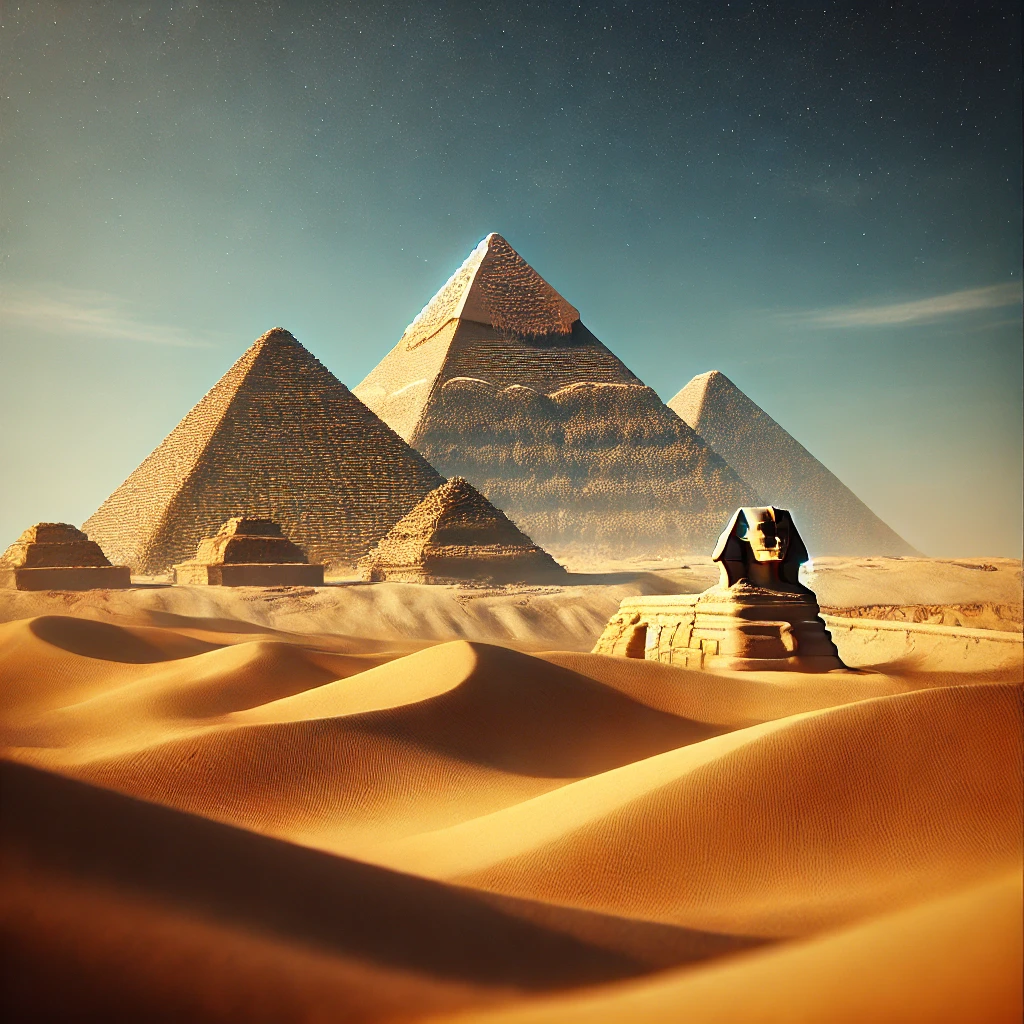The Pyramids of Giza, located near Cairo, Egypt, are among the most iconic and enduring architectural marvels of the ancient world. Built during the Fourth Dynasty of the Old Kingdom (circa 2600–2500 BCE), these pyramids served as monumental tombs for pharaohs and are renowned for their precise construction, historical significance, and enduring mystery.
Key Features
- Great Pyramid of Giza
- Built for Pharaoh Khufu (Cheops), it is the largest and most famous of the three pyramids. Originally 146.6 meters tall (now 138.8 meters), it was the tallest man-made structure in the world for over 3,800 years.
- Pyramid of Khafre
- Built for Khufu’s son, Khafre, this pyramid appears taller than the Great Pyramid due to its elevated location. It is associated with the Great Sphinx, a limestone statue thought to represent Khafre himself.
- Pyramid of Menkaure
- The smallest of the three main pyramids, it was built for Pharaoh Menkaure and is distinguished by its finer masonry and inclusion of several smaller satellite pyramids.
- Construction
- Made from limestone and granite, the pyramids were constructed with remarkable precision, using techniques that remain subjects of debate and fascination.
Cultural and Historical Significance
- Symbolism
- The pyramids represent the Egyptians’ deep spiritual beliefs, particularly in the afterlife and the pharaohs’ divine connection to the gods.
- Architectural Mastery
- The precise alignment of the pyramids with celestial bodies, including the Orion constellation, highlights the ancient Egyptians’ advanced understanding of astronomy.
- Historical Importance
- The pyramids are part of a larger complex that includes temples, causeways, and smaller pyramids, reflecting the social and religious complexity of ancient Egypt.
Mysteries and Theories
- Construction Techniques
- The methods used to construct the pyramids, including transporting massive stones and achieving precise alignment, remain subjects of scholarly research and debate.
- Symbolic Alignment
- Some theories suggest that the layout of the pyramids mirrors the Orion Belt stars, linking them to ancient cosmological beliefs.
- Hidden Chambers
- Ongoing explorations using advanced technology, such as muon imaging, continue to search for hidden chambers and passageways.
Modern Relevance
- Tourism
- The Pyramids of Giza are a UNESCO World Heritage Site and attract millions of visitors annually, contributing significantly to Egypt’s tourism industry.
- Archaeological Research
- The site continues to provide invaluable insights into ancient Egyptian society, engineering, and culture.
- Cultural Legacy
- As symbols of ancient ingenuity and spiritual devotion, the pyramids remain enduring icons of human achievement.
Spiritual and Mystical Perspectives
- Energetic Properties
- Some spiritual traditions believe the pyramids hold metaphysical energy, aligning with Earth’s energy grid and serving as sites for meditation and healing.
- Sacred Geometry
- The pyramid’s shape is thought to embody principles of sacred geometry, symbolizing harmony, balance, and spiritual ascension.
- Cosmic Connection
- The pyramids’ alignment with celestial bodies suggests they were designed to connect the earthly and divine realms.
Related Concepts
- Ancient Egyptian Beliefs: The spiritual and cultural context of the pyramids.
- Sacred Geometry: The mathematical principles thought to underpin the pyramids’ design.
- Orion Correlation Theory: A hypothesis linking the pyramids to the stars of Orion’s Belt.
Further Exploration
- The Role of the Pyramids in Egyptian Spirituality
- Modern Archaeological Discoveries at Giza
- The Mysteries of Pyramid Construction Techniques
The Pyramids of Giza stand as timeless symbols of human ingenuity, spiritual aspiration, and the enduring legacy of ancient Egypt. Their significance transcends time, continuing to inspire awe and curiosity in the modern world.

